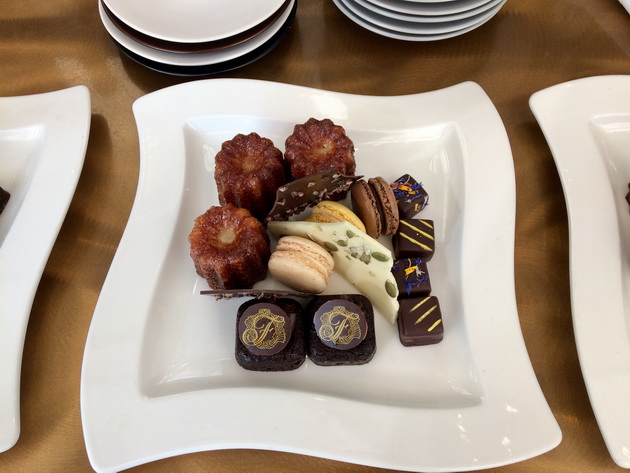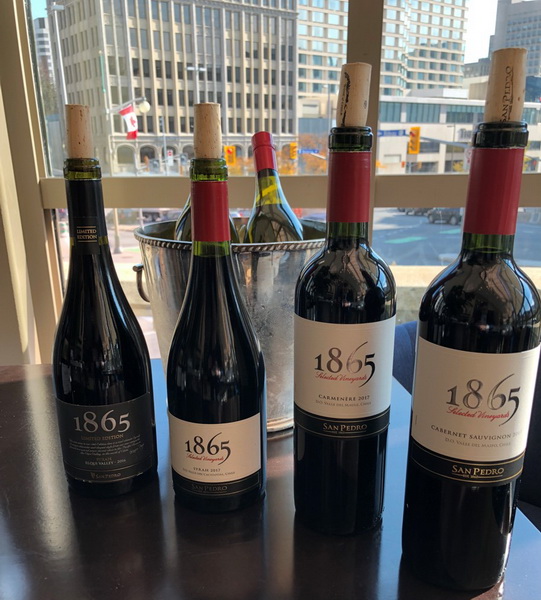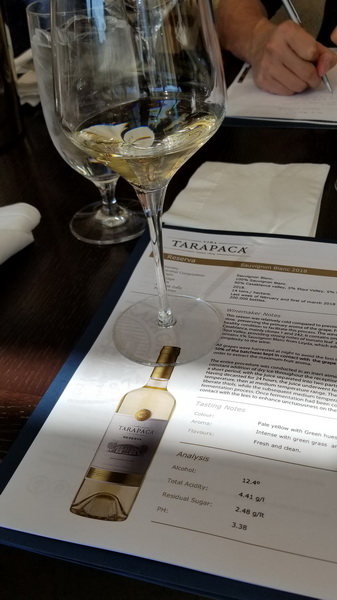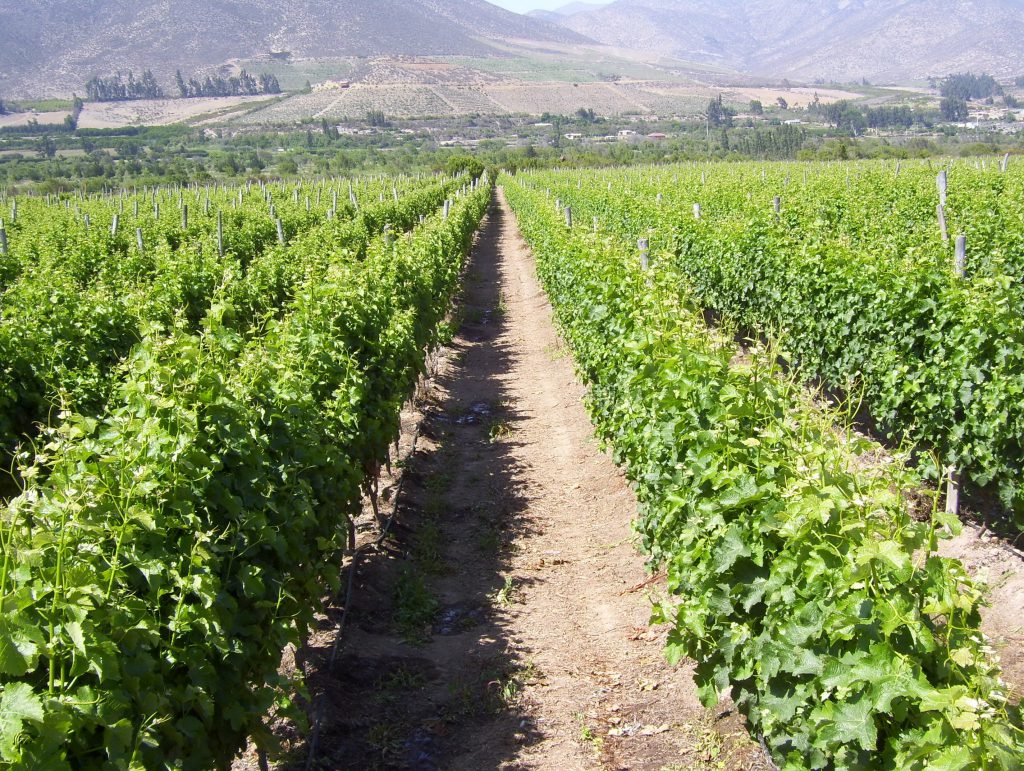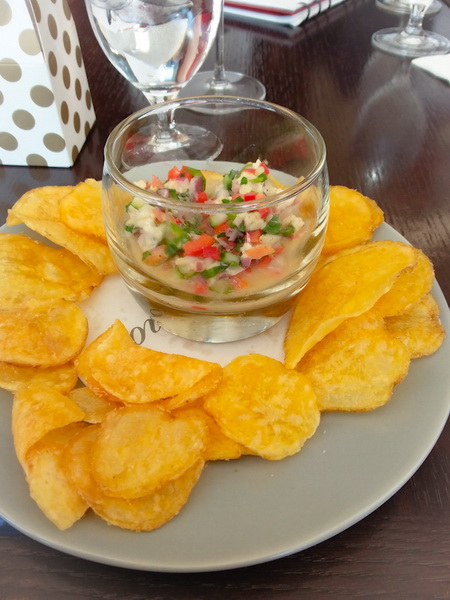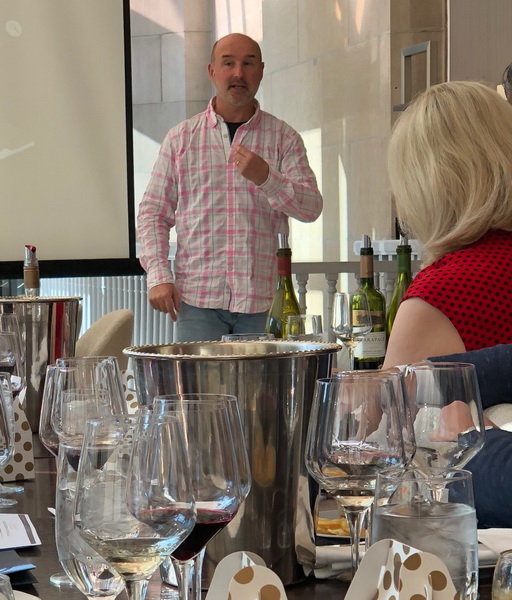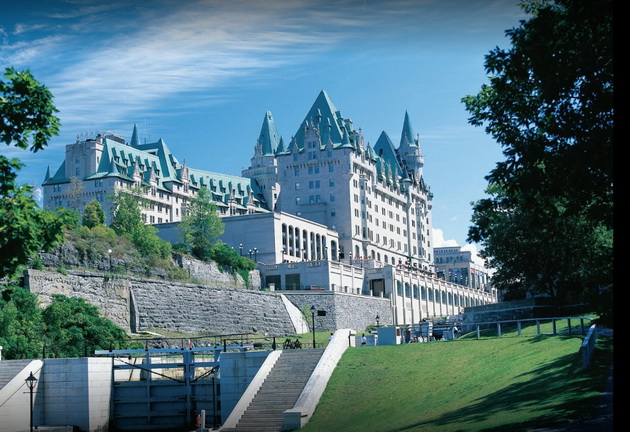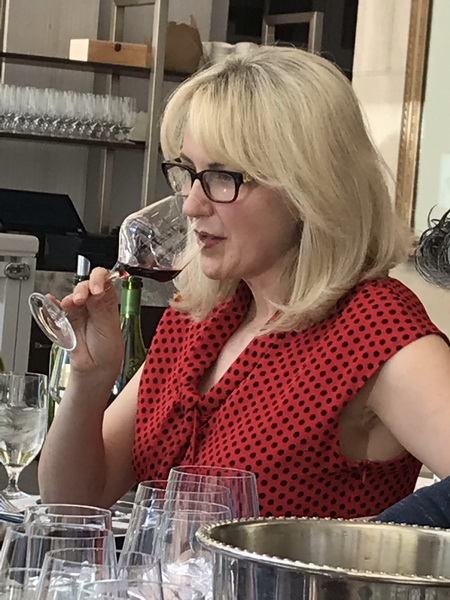 Jane Staples
Jane Staples
Wine, Food &Travel Writer,Accredited Sommelier
Viña Tarapacá and San Pedro 1865 Winetasting at ZOE’S LOUNGE
Exciting things are happening in Chile’s winemaking industry! The world is recognizing the fine craftsmanship and distinctive personality of Chilean wines. Chile is also becoming a world leader in organic and sustainable viticulture.
I recently attended a tutored tasting with two award-winning winemakers, Sebastian Ruiz from Viña Tarapacá and Matias Cruzat from San Pedro 1865. Our team of wine writers happily gathered at the comfortable Zoe’s Lounge in Ottawa’s Chateau Laurier.
 Matias Cruzat Photo: Jane Staples
Matias Cruzat Photo: Jane Staples
Each winemaker led highly informative and engaging sessions to introduce us to several of their their wine products, during which we also enjoyed a luxurious meal of foods, matched to the wines we were studying. Both Ruiz and Cruzat presented their wines in the context of their regions, weather patterns and soil type, giving us an in depth understanding of their viticultural background. We also discussed food pairings and learned about a popular Chilean dish, “Pichanga”, an appetizer of pickled vegetables.
 Sebastian Ruiz Flano Photo: Jane Staples
Sebastian Ruiz Flano Photo: Jane Staples
I was impressed by the distinctive flavours and spicing elements used in Chilean wines, e.g., the papaya flavours in the 1865 Chardonnay. I also loved the savoury spicing elements of paprika, white pepper and nutmeg in the Carmenères we tasted . These are such memorable wines!
We were treated to a sample of San Pedro’s Limited Edition Syrah 2016, to wrap up the tasting. Rich and aromatic, with a savoury mouth-watering palate, this was my favourite wine discovery of the day. It’s an ideal match with “Pichanga”.
The other happy discovery about Chilean wines is their moderate prices. When you are looking for excellent value at reasonable prices, look for Chilean wines. You will discover a wide range of both whites and reds, suitable for every palate.
 Matias Cruzat Photo: Jane Staples
Matias Cruzat Photo: Jane Staples
We all left the tasting feeling very contented and grateful for the opportunity to expand our wine knowledge. A big round of applause goes to Sebastian Ruiz and Matias Cruzat for this excellent presentation! I hope they return soon!
 Sebastian Ruiz Flano, Matias Cruzat and Natalie MacLean Photo: Jane Staples
Sebastian Ruiz Flano, Matias Cruzat and Natalie MacLean Photo: Jane Staples
Christian Marcoux
Last Tuesday, I was invited to the Chateau Laurier to attend a tasting from Vina San Pedro’s Properties: 1865 Single Vineyards and Tarapaca. Both wineries are known for their excellent wine, year after year.
Chilean wines have always had a place in our market. Their quality for price range make them an easy choice for the North American consumer. Lately, many wine critics acclaimed Chilean wine making and their products. It is therefore with high expectations that I was looking forward to this tasting.
It is worth noting that Chile is quite a unique country. It is one of the longest countries in the world from South to North, covering 4,300 km, yet only 350 km from East to West. The high peaks of the Andes offer a perfect microclimate to sustain wine growing in many regions of Chile. As explained by the winemakers, the effect of the Humboldt Current, also called the Peru Current, helps moderate the temperature inland which affects the wine region.
During the presentation, both winemakers surprised me by explaining how refrigerated trucks are involved during the harvest season, to transport fresh picked grapes to the main facilities, sometime driving through the night, covering hundreds of kilometers. The logistic of having fleets of trucks, drivers and other personnel, all looking after the success of such time-sensitive operations, while keeping prices low, is very remarkable.
From the beginning of the presentation, both winemakers explained that they find new ways to improve both quality and quantity of their wine by using new technologies. For example, drone and geological surveys were used to find the best growing environment for the grapes, knowing which soil will bring a more robust vine with a better yield, and hopefully less disease.
One thing I appreciate from a good winemaker is their never-ending quest to further improve their wine, by keeping up with new technology, as well as using environmentally friendly methods.
Ten years ago, Chilean wine was perceived as low-quality wine that lacks character and personality. Since then, Chilean winemakers have applied new and improved winemaking techniques.
Tuesday’s tasting has confirmed that Chilean wines are not only affordable, but rich in quality. Year after year, Chilean wines are obtaining 100 Point ratings and are critically acclaimed in several world renown magazines. I drink Chilean wine on a regular basis and am always pleased with the quality and maturity of their wine.
This recent Chilean wine tasting experience was not only an eye opener, but a confirmation that the sky is the limit for Chilean wine.
A few trivia questions:
What is the grape that Chilean winemakers used to think was Merlot? “Carmenere”.
What is the name of the main current riding along the Chilean coast? “The Humboldt Current, also called the Peru Current”.
What is the name of the mountain chain dividing Chile and Argentina? “Andes”.
My favorite piece of history is related of the age of the wineries. It is interesting to learn about their evolution and the new ideas coming from open-minded winemakers and how they adapt to the ever-changing market.
Jennifer MacDonald Havers
Wine Columnist, Ottawa Citizen
Our tasting group enjoyed a beautiful, sunny (although cold outside) lunch with two amazing Chilean winemakers – Sebastien and Matias. We were able to taste some of their new vintages, as well, learning some of the unique characteristics of Chilean wine.
Both wineries are historic, with San Pedro having celebrated their 150th anniversary recently, founded in 1865. Tarapaca was founded in 1874. Both Sebatien and Matias seemed to share similar experiences in their winemaking techniques and approach to the Chilean climate and terroir and so it was lovely to hear from them together.
 Sebastian Ruiz Flano Photo: Jennifer MacDonald
Sebastian Ruiz Flano Photo: Jennifer MacDonald
One surprising thing about winemaking in Chile is the impressive variability of the climate and the challenges this brings. The difference in several degrees latitude can mean a significant difference in climate and weather conditions. Many assume (as I thought initially), that Chile is a warm winemaking region, but mountains, altitude, as well as proximity to the ocean of many winemaking areas, such as the Elqui and Leyda Valleys, all experience moderating factors. Those cool breezes from the Andes mountains in the morning and the Pacific Ocean in the afternoon, as well as the influence of the Humboldt Current, can slow ripening, prevent sugar levels from getting too high, and help wines to maintain their natural acidity. This is especially evident in the wines we tasted from both winemakers.
One thing that was also re-enforced for me, was the impact that changing weather patterns has on the winemakers, and winemaking process. 2017 was a very dry and warm year in the Elqui Valley, resulting in the harvest beginning weeks earlier than anticipated in February. Since timing is a huge part of winemaking and grape growing, it will be interesting to see how winemakers adapt their expectations with future vintages, needing to shift their planning and adapt, literally, at the drop of a hat, in order to protect the harvest and resulting wine. Not a job for the faint of heart!
The white wines were definitely a highlight as I thought they perfectly complimented our discussions about the terroir, climate and the impact of these factors on the wine. The Sauvignon Blanc from both winemakers showed lovely balance, brightness, and acidity. The reds as well showed beautiful warmth, fruit, and spice that are so complementary to Cabernet Sauvignon and Syrah. It was a wonderful opportunity to meet both of these winemakers and experience their wines with them.
Matias joined Viña San Pedro’s team aiming to build upon the winemaking identity at the winery with the country’s most important and iconic viticultural origins. In this way, the true homeland that Chile has to offer can be revealed through the 1865 range. He has significant experience across wineries in California, USA as well as South Africa, where he spent several seasons as a harvest assistant, carrying out fermentation and pressing duties. This valuable experience brought him back to Chile to train as a winemaker. He participated in Viña Undurraga’s 2012 harvest in the Maipo Valley and a few months later, worked as assistant winemaker for Viña Santa Cruz in the Colchagua Valley. One year later Matias took part in Viña San Pedro’s 2013 harvest in Molina. Upon completion of the season, he was recruited because of his dedication and talent, joining the winemaking team for the winery’s Premium brands.
The same year the innovative winemaker and three business partners launched a digital tool: Hello Wine, encouraging you to taste and get to know Chilean wines as part of a wine home delivery club.
Today, Cruzat rises to the important challenge of taking wines from the 1865 portfolio to the highest level, exploring new frontiers and innovating with his professionalism and winemaking experience. Matías Cruzat graduated in Agronomy with a special mention in Viticulture and Winemaking from the Pontificia Universidad Católica de Chile.
San Pedro 1865 Chardonnay 2017
Elquí Valley, Chile
San Pedro 1865 Selected Vineyards Cabernet Sauvignon 2017
Maipo Valley, Chile
San Pedro 1865 Sauvignon Blanc 2017
Leyda Valley, Chile
San Pedro 1865 Selected Vineyards Carmenère 2017
Maule Valley D.O., Chile
Viña San Pedro 1865 Single Vineyard Syrah 2017
Cachapoal Valley, Chile
San Pedro 1865 Vineyard Limited Edition Syrah 2016
Chile
Tarapaca Reserva Sauvignon Blanc 2017
Chile
Tarapaca Gran Reserva Sauvignon Blanc 2017
Chile
Tarapaca Gran Reserva Chardonnay 2017
Maipo Valley, Chile
Viña Tarapacá Gran Reserva Cabernet Sauvignon 2017
Maipo Valley, Chile
Viña Tarapacá Gran Reserva Carmenère 2017
Maipo Valley, Chile

Andrea Shapiro
Accredited Sommelier
I arrived at Zoe’s Lounge in the historic Chateau Laurier to take part in an exclusive, featured tasting of Vina San Pedro’s Tarapaca and 1865 wines.
After being introduced to winemaker Sebastián Ruiz the first wine we sampled was Tarapaca’s Sauvignon Blanc Reserva in the 2018 vintage. The grapes were harvested in the late night evening of the last week of February and beginning of March from Casablanca, Elqui and Leyda Valleys. The aromas and flavours were bright and fresh with pomelo citrus, lemon peel, green mango and fresh cilantro herbal notes.
The next wine that was served to us was another Sauvignon Blanc which was light, delicate and full of refined subtle freshness. Grown in the Leyda Valley on granite soils, it offered a delicate expression with grapefruit and soft dried clover with a subdued rocky mineral and green bean presence. It was a perfect accompaniment to the shrimp and scallop ceviche that is was paired with.
Nestled between the two Sauvignon Blancs was a bold red wine, a Cabernet Sauvignon. This was the Reserva and how delectable it was! A blend of grapes from different Maipo Valley vineyards offered a captivating contrast between the white wines on either side.
Winemaker, Matias Cruzat then presented to us some featured wines from 1865, starting with the Sauvignon Blanc, 2017 vintage. Also hailing from their best-selected vineyards in the Leyda Valley, located four kilometres from the ocean, offered features distinct to the coastal climate. The wine had vibrant green aromatics of granny smith apples, lemon peels and sea salt minerals with flavours that show fresh mouthwatering tropical slices of kiwi fruit, nectarines and white pepper. The acidity was high and well balanced against the succulent medium minus, body and finish.
Amongst the many wines that followed, there was certainly a stand out; the Limited Edition Syrah from the Elqui Valley. The 2015 and 2016 years were particularly wet, with each rainfall doubling that of the previous year, delicately filling the soils with little ponds of water. The vineyard itself was protected due to the location, safe from temperature flux and variations. The wine, deeply ruby coloured with a vivacious purple hue, had an exquisite intricate bouquet that revealed cassis, smoked meat and black olive richness. Succulent flavours imparted an alluring gorgeous earthy element of mushrooms, rose petals, dark chocolate and dried fruit. This continued on into the full finish and body; evolving and lingering deep into the palate.
The Limited Edition Syrah was also a perfect partner for the decadent desserts that were offered. A variety of tasty treats: chocolate bark, truffles and macarons crafted with care.
Educational and enduring, it was an enlightening day spent with these two eloquent and enlivened winemakers. From Carmenere to Syrah and Chardonnay, I learned about the different styles, efforts and elements that went into these delectable wines and was offered a revealing glance at Chilean winemaking and the artistically crafted fruits of these labours.
David Skinner
Wine & Travel Columnist, Outdoor Magazine
Chile may be the world’s narrowest country but when it comes to the production of wines, it’s breadth of terroir provides a backbone for a wide range of varietals.
Squeezed between the Pacific Ocean and the Andes mountains, there are three quite distinct regions that have evolved to become ideal sites for quality-driven winemakers. Showcasing the wines of Viña Tarapaca and 1865 Vineyards, Ottawa’s sommeliers were treated to some of the benchmark examples from winemakers Sebastián Ruiz Flaño and Matías Cruzat Underraga respectively. Together they emphasized how the country’s unique geography and soils form the foundation for great wines.
 Sebastián Ruiz Flaño Photo: David Skinner
Sebastián Ruiz Flaño Photo: David Skinner
Chile’s coastal regions are cooled by ocean breezes that keep the acidity levels high enough to favor cool climate styles of Sauvignon Blanc and Chardonnay. Further inland, the valleys that have been carved from the land by rivers like the Maipo, are warmed by a generously sunny exposure and are perfect for Bordeaux grapes.
When it comes to great conditions for Syrah and Malbec, viticulturists can gain an advantage in the higher elevations on mountain slopes.
 Matías Cruzat Underraga Photo: David Skinner
Matías Cruzat Underraga Photo: David Skinner
This diversity permits a winemaker to select the perfect sites for the types of grapes they wish to use in making different styles of single varietals and blends. In fact, the possibilities seem endless, but Chile has become famous for some well-defined wines that rival many famous old-world locations.
The tasting, accompanied by a fine selection of small plates from the Fairmont Chateau Laurier, focused on Sauvignon Blanc, Chardonnay, Cabernet Sauvignon and Carménère. Of course, the latter has evolved to become Chile’s popular benchmark grape after having been originally mistaken for Merlot in the early 1900s. With that being said, our hosts were confident in their belief that the best Cabernet Sauvignon in the world can be found in the Maipo region.
Soils and microclimate dominate the considerations for choosing the best sites for vineyards, but the macroclimate has had a clear impact on the crops. Both winemakers agreed that there has been a trend toward earlier ripening of fruit that has pushed recent vintage harvests into April. Since the historical month for picking in Chile has been May (remember that this is the southern hemisphere), a one-month shift is clearly challenging.
The natural variation in maturation period for grapes can usually allow for staggered delivery of crops to the wine-making facility, but when all the vineyards hit the perfect acid and sugar levels at the same time, it creates a logistical nightmare. But such challenges aren’t new to these professionals. With some vineyards a great distance from the production facility, quality assurance is achieved by using refrigerated trucks for the trek from vine to crush. For example, the grapes in the 1865 Selected Vineyards Chardonnay come from the Elqui valley, a mere 10 hours away from the wine-making facility.
Tasting the selected offerings, in conjunction with the creative culinary samples, added a synergistic dimension to the wines. My personal preferences favored the Cabs from both producers.
The 2017 Tarapaca Gran Reserva Cabernet Sauvignon was driven by red fruits (strawberry and raspberry) with support from more subtle plum and cassis aromas accentuated by spices.
The 1865 Selected Vineyards Cabernet Sauvignon (also 2017) presented a red currant, cherry and raspberry nose with that characteristic spice chaser.
On the palate, both were medium bodied wines and the flavours mimicked the aromatics They were well balanced with smooth tannins and solid acidity. The finish lingered pleasantly, reflecting a nice complexity
While tasting, the term “sucrocity” was coined by Matias, to describe a feeling of sweetness in a wine that has no residual sugar. While it likely is a result of a number of techniques that relate to acid levels, the term certainly is apt when describing such a sensation in tasting notes.
Something that was recognized by the group and acknowledged by the winemakers, is that Chilean reds seem to have a more spice-driven profile. While some tobacco and earth tones can be found along with exemplary fruit, the regional character is quite distinct and pleasurable.
Chile may span many latitudes and less than one longitude, but it is home to some fantastic wines.
Greg Hughes
Wine Writer & Sommelier
Enjoying ceviche and charcuterie with Sebastián Ruiz and Matías Cruzat was an absolute pleasure; both representing their dynamic regions with enthusiasm.
Though Chile has a reputation for value in the wine community, I would like to see people appreciate the narrow western shore of South America, notable for their tremendous range.
Weather protected valleys, producing inviting reds, is only the starting point for any understanding of Chile’s potential.
There is so much coastal land being utilized. So many unique soil types. It was a pleasure to taste some of the Elquí wines produced from San Pedro’s 1865 range.
Unlike its southerly neighbours, this region connects the shoreline to the Atacama dessert. The Atacama is a popular backdrop for movies set on desolate and barren wastelands. Yet, close to the shore, the pictures we saw were temperate and fantastically alive.
The Chardonnay and Syrah San Pedro have planted there, produce wines worth talking about.
The Chardonnay was soft and inviting. Only a tiny portion of malolactic. Well managed elevage in barrels had preserved the fruit, as well. Soft yellow apple and lemon, to the palate.
We tried two Syrah. Both were beautifully aromatic. Delicate fruit to their entry level example. Some subtle spice. Very refreshing amd not overly heavy or alcoholic. Extremely new world.
The second wine was already burned into the minds of most of the attendees (from the previous visit almost a year ago). It was their limited release Syrah. This wine was a wine of concentration and depth. Dense cassis and plum (almost Barossa-like), but more chiseled and lean.
Tarapaca impressed with their ramge, as well. Their Carmenere from the Maipo river valley is always a welcome sight. It has the wonderful spices ripe Carmenere usually flaunts; sweet chai spices, turmeric, damson, cherry, and blackberry.
They described the inviting mouthfeel we usually sense as “sucrosity.” It’s an interesting way of describing such a full flavoured (often tannic) grape and why it can still remain so ripe and generous.
Their whites were eye-popping. Their Sauvignon Blanc was a tropical delight and the Chardonnay was a textbook example of malolactic done right; rich, tasty, and with a ton of well preserved fruit.
Their innovative practices fascinating. Preservation of the grape’s integrity in the heat, is key to producing a well made white. Utilizing dry ice in their storage and transportation, is an ingenious way to prevent grape breakdown and premature oxidation.
This is a winemaking country that deserves the keen attention of the educated public.
With a long history and continual success in crafting their unique niche, I am excited to see what the future holds. As a side note, I have heard rumours that San Pedro has been growing in another new cool region: Itata. I can’t wait to try it!
I would like to thank the talented organizers of Phillipe Dandurand Wine amd the Chateau Laurier for a wonderfun experience.
Gwen Barton
Accredited Sommelier
Our tasting team had the privilege of participating in a combined tasting event with two established and notable wine producers in Chile: 1865 and Vina Tarapacá. Chile has a long and successful history of producing new world wines and many at a very affordable price point. Both wineries were established in the latter half of the 1800’s with a strong Spanish and French influence, a result of Europeans trying to find a supply solution to their phylloxera ravaged vineyards.
Being sandwiched between the natural borders of the Pacific Ocean and the Andes mountains, the vineyards in Chile have, for the most part, perfect climate conditions for growing grapes. However, they can be extremely susceptible to variations in Chilean weather. In event of extremely hot seasons, rainy patches or high winds, decisions on harvesting, down to the time of day, must be made quickly to ensure resulting wine produced is the highest possible quality.
Of great interest to me during the presentations and follow up Q&A with the group, was the focus discussion on the terroir. Within such small geography, there is great variation in soil types from sandy-loam to pebbly gravel and nutrient rich volcanic soil. The presenters were able to describe why specific grapes thrive in certain soils and shared the extensive investigation behind planting decisions. Soil research findings are taken seriously, to the point where, if results show that vines would do better if moved to a more conducive vineyard, they are removed and replanted. Clearly, these changes of direction require significant financial investment, all to ensure perfect conditions for wine production.
One particular learning for me was a better understanding of “sucrocity”. For those who don’t know, sucrocity is a term given to the perceived sweetness experienced on the finish of a wine, even though the wine is dry. This was very evident on 1865 Select Vineyards Carmenere which had a residual sugar of 2.5 g/L, however, the persistent ripe red cherry and raspberry flavours were able to fool the mouth leaving a long, sweet, fruity finish. This is a key factor when doing food pairings. While not enough sugar to support a sweet, it could easily be paired with strong cheeses at the end of a meal.
Jon Steeves
Accredited Sommelier
On October 23rd, I had the pleasure of meeting with a select group of sommeliers, to experience the new releases from 1865 Selected Vineyards and Tarapaca wines and to learn about the terroir from the wine makers themselves, including Matias Cruzat Undurraga, 1865 winemaker and Sebastien Ruiz, Chief winemaker of Vina Tarapaca.
Although I haven’t been to Chile, I have experienced several Chilean wines from abroad. I was impressed by the winemaker’s explanations of soil and terroir, with detailed exploration of the sub-regional differential with the Leyda Valley, the Casablanca Valley, Elqui Valley, and the Maipo Valley. The unique characteristics of continental and ocean front coastal microclimates produces interesting effects on wine style.
I was surprised to experience the 1865 – Rosario Estate from abroad, with a gorgeous drone-filmed video of the estate, giving a sense of almost touching the vineyards and fruit, while experiencing a wine from the estate. The Vina Tarapaca 360 sustainable program was impressive as well. I appreciated the 4 pillar sustainable growing program focus on 1) environment, 2) water measurement and management, 3) social commitment and wellbeing and 4) quality.
The winemakers both provided several personal anecdotes. My favourite was one pertaining to how 2016 season impacted 2017 season fruit potential: “season was a markedly cool, cloudy year in Maipo Valley, leading to low yields in 2017, because the prior season determines the following year’s fruiting potential”.
Learning how the brand 1865 was created and launched in 1997, at the 150 year mark of the winery’s founding, offered a sense of viticulture and viniculture lineage, and reinforced how Chile, being a new world wine region, has a longstanding tradition of wine making and terroir, suited well for winemaking.
In trying the flight of wines, experiencing a small pinch of Chilean terroir, has left me with a desire to try more of these gorgeous wines, and to visit Chile for myself.
Lori Kilmartin
Accredited Sommelier & Wine Writer
Tarapacá and San Pedro Single Vineyard 1865 Wine Tasting
I had the pleasure of attending a Chilean wine tasting hosted by VSPT Wine Group and their agent Philippe Dandurand Wines Ltd on October 23rd.
VSPT is the second largest exporter of Chilean wine and a significant participant in their market. They have several brands under their umbrella, however this tasting was focused on two in their portfolio; Viña Tarapacá and San Pedro 1865.
Winemaker Sebastián Ruiz, Chief winemaker at Tarapacá, led us through the Sauvignon Blanc and Cabernet Sauvignon Reserva wines, followed by the Grand Reserva Sauvignon Blanc, Chardonnay, Carmenère and Cabernet Sauvignon.
Sebastián was animated and obviously very proud of the wines he had produced. His objective is to make wines that represent the terroir of the Maipo Valley. I found it fascinating that to achieve this at the Rosario Estate, they recently excavated several “pits” to analyze the soil. As he said: “the relation between soil and wine is important to decide what to grow”. They will be taking this new data and from it determining what are the best grapes to grow based on the terroir.
According to Sebastián, Maipo Valley makes some of the best Cabernet Sauvignon in the world for two reasons; 1) the volcanic soil has lots of iron and magnesium giving a good backbone of minerality and 2) because of the location of the winery, they get a good breeze from the Andes in the morning and in the afternoon from the nearby Pacific Ocean to temper the high temperatures during the hot spring and summer months.
Winemaker Matías Cruzat, Enologist for the San Pedro 1865 Single Vineyard Wines, was equally as effusive and proud of his wines. Viña San Pedro was founded in the Curicó Valley in 1865 by the Correa Albano brothers. The wines come from specific plots that give a unique personality that can differ each vintage due to weather variations.
It was very interesting to taste the difference between the 2017 100% Syrah from the Los Quillayes vineyard in the Cachapoal Andes Valley, compared to the 2016 Limited Edition 100% Syrah from the Elqui Valley. The Los Quillayes Syrah was a more typical Syrah with aromas of ripe fruit, spice and pepper with savoury fruits on the palate while the Limited Edition was much darker in colour and in intensity in both aromas and flavours.
There was typical black pepper but also grilled/cured meats and herbal notes. I have to be honest, when Matías said it would be the perfect match for Pichanga, I had to Google what that was! After looking at the ingredients, I have to agree, this would make a great pairing. So, just in case you are able to pick up a bottle of this special Limited Edition, here is the recipe to go with it! Enjoy!
PICHANGA, CHILEAN RECIPE
Serves 8 people
Ingredients:
1/2 pound of smoked pork ham, 1/2 inch thick
1/2 pound of mortadella or beef bologna, thick
1/2 pound of cheese, sliced thick (Muenster or Havarti)
1/2 pound of assorted olives
1/2 pound of assorted veggies pickled: onions, cauliflower, carrots with juice
Optional: roasted tomatoes in oil, fresh carrots, diced cooked potatoes, hard goat cheese in cubes.
Mix everything in a bowl. I let it sit refrigerated for one night. Serve with fresh bread.
Lynn van der Linde
Accredited Sommelier
Melanie Lloyd
Accredited Sommelier & Writer
On October 23, I had the privilege of attending the Viña San Pedro’s wine tasting held at Zoe’s in the Chateau Laurier. The presentation was conducted by two winemakers: Sebastián Ruiz from Viña Tarapacá, and Matias Cruzat from 1865 Single Vineyards. Here are my observations.
 Sebastián Ruiz Photo Melanie Lloyd
Sebastián Ruiz Photo Melanie Lloyd
Interesting facts about recent harvest years:
When talking about Tarapacá Gran Reserva Cabernet Sauvignon 2016, Sebastián Ruiz mentioned that 2016 was a difficult year because of the amount of rain they received in mid April. That said, they were still able to produce wonderful wine. He then mentioned that 2018, in his opinion, has been one of the best harvests for Chilean wines. So, here’s a tip to the readers: Be on the lookout, in a couple of years, for 2018 Chilean wines. They should be wonderful, fruity, and flavourful.
 Matias Cruzat Photo Melanie Lloyd
Matias Cruzat Photo Melanie Lloyd
Matias Cruzat mentioned that 2017 was challenging due to the warm weather. Many of the grapes, such as Carménère and Cabernet Sauvignon, were harvested 3 weeks early. The grapes for the 1865 Sauvignon Blanc grew in the coastal valley which created a buffer affect so the grapes were protected more than in other areas.
Interesting information regarding some of the terroir:
The Maipo Valley has lots of different types of soil. It helps give structure and character to the wine. It is one of the best places to produce Cabernet Sauvignon according to Sebastián Ruiz. He said this area produces Cabernet Sauvignon that has tannins that are present, but in a delicate way.
The Maule Valley is one of the biggest valleys in Chile. Matias Cruzat mentioned it is a very trendy spot for wine and 99% of the grapes grown there belong to the red varieties. It produces excellent Carménère among other varieties.
My observations:
Both the red and white wines sampled, were complex and sophisticated. I enjoyed all the wine tasted. When it came to red wine, I was pleasantly surprised at how fresh and tart they were. I also liked that the tannins tended to be gentle and smooth. My personal favourite wine was the 1865 Limited Edition Syrah 2016 from the Elqui Valley. It had a unique and fragrant nose. It had meaty and hearty aromas such as black olives, but then on the palate, it was fresh and juicy with nice acidity.
In terms of trivia and history:
1865 is named after the year that Viña San Pedro was founded. Another little piece of history I found interesting is that Carménère was lost in Chile until it was rediscovered in 1994. Today, with 20 + years experience, Chile produces excellent Carménère.
Pam Chiles
Wine & Food Writer
Vina Tarapaca & 1865 San Pedro Tasting October 23, 2018
We spent a delicious afternoon tasting through the wines of San Pedro and Tarapaca at the Château Laurier. The wineries are both part of the VSPT Group – the second largest exporter of wine in Chile (2008).
Winemaker Sebastian Ruiz Flano took us through the wines of Tarapaca, centred in the Maipo Valley. He explained how it is an ideal place for growing grapes, as the climate is regulated by the Humboldt current, off the coast in the Pacific, and by the spring and summer breezes that moderate the temperatures (morning from the Andes, afternoon from the ocean), giving grapes their fruity character.
Sebastian Ruiz Flano Photo: Pam Chiles
The geography of the Tarapaca’s main estate (El Rosario, from which their top reds are sourced) is quite interesting – set in a horseshoe-shaped basin surrounded and protected by hills and mountains with the open end towards the Maipo river and composed of a variety of soil types. They call it “Maipo Valley’s natural clos.”
The winery recently undertook an extensive soil study in their vineyards. Trenches were dug up to 2m in depth to examine soil profile and composition, which ranges from clay and sandy loams, to sandy gravels and conglomerates; fluvial/alluvial to decomposed volcanics, and granites (for those of you interested in dirt!) As a result, some parcels of vines will be up-rooted and new vines planted according to soil preference, with a view to ensuring the best quality grapes for the terrain (for example, Cabernet Sauvignon will be replanted in its preferred soil: sandy gravel).
The white wines of Tarapaca are refreshing and pair well with seafood. The reds are fruity and balanced. All are great value.
Continuing our Chilean journey, winemaker Matias Cruzat guided us through the 1865 portfolio; the signature wines of Vina San Pedro. Wine is produced from vineyards in the Maipo, Leyda, Maule and Elqui valleys with all grapes transported in refrigerated trucks, to the central winemaking facility outside Santiago; some journeys lasting up to 10 hours.
The wines we tasted were mainly from the 2017 vintage. Matias described it as a “rough year” (in the context of white wines) as the season was warmer than usual, the Elqui Valley being the exception (due to proximity to the Pacific). Cabernet Sauvignon was harvested 2 to 3 weeks earlier than usual. Although a difficult year, it was not noticeable in the bottle – the wines are excellent.
Nonetheless, both Sebastian and Matias have noticed a trend, in the last few years, to earlier harvests than normal, in Chile.
Food pairings at Zoe’s were perfectly on-point. Many thanks to Matias and Sebastian for travelling the distance to share their wonderful wines.
Watch out for these wines as they are released in various parts of Canada over the next few months. There are a few bottles left of previous vintages at the LCBO if you have a search around!
Dr. Simon Chen
Accredited Sommelier
We had the opportunity to again meet with Matias Cruzat, the winemaker of the San Pedro 1865, after his visit last year. In addition, this time we are also joined with Sebastian Ruiz, the winemaker for Vina Tarapaca. What an opportunity to learn about the viniculture in Chile from two winemakers.
The venue took place at the beautiful Zoe Lounge in Fairmount Chateau Laurier. During the wine luncheon today, we spent a lot of time talking about vintage differences, regional differences, and even to the soil differences. My favorite quote from today that really reflects how good Chilean wine has become is that 20 years ago, we only knew to plant red and white grapes. Then 10 years ago, we were harvesting different grape varietals in a wrong order, but today, we not only know when is the best to harvest, we also know what region is the best for which grape varietals.
We sampled 12 wines from two wineries that ranged from Sauvignon Blanc and Chardonnay, to Carmenere, Shiraz, and Cabernet Sauvignon. Surprisingly, most of these wines come from many different regions in Chile.
For example in San Pedro 1865, their Chardonnay and Pinot Noir come from Elqui Valley, which is 550 km north from Santiago. Their Sauvignon Blanc comes from Leyda Valley, which is 103 km west from Santiago. The Carmenere is from Maule Valley, which is 277 km south from Santiago. Lastly, their Cabernet Sauvignon is from the famous Maipo Valley and it is only a 30 min drive from Santiago.
I was surprised after the conversation, because people often just call Chilean wines — ‘chilean wines’ and in our naïve impression, they just all come from Chile. However, they have matured so much now that perhaps one day, we should call ‘Maipo wines’, ‘Leyda wines’, or ‘Elqui wines’, similar to when we talk about ‘Bordeaux wine’, ‘Burgundy wine’, or ‘Rhone wine’.
The light lunch that was provided also matched beautifully with the wine. The ceviche goes really well with the Tarapaca Gran Reserva Sauvignon Blanc. Compared to their Reserva Sauv. Blanc, the Gran Reserva has more body, that can hold the acidity from the ceviche. It also has tropical, grassy fresh flavors to enhance the seafood sweetness. The trio was grilled fish, duck breast, and roast beef. I paired with San Pedro 1865 Chardonnay, San Pedro 1865 Syrah, and San Pedro 1865 Limited Syrah.
One important thing that I experienced from this tasting, together with the tasting last year with San Pedro 1865, is ‘consistency’. Matias and Sebastian are making wines that have very consistent quality and flavour profiles across vintages. So as a consumer, you know you can trust their wines year in and year out.
Especially for the 2017 vintage, it was an extremely hot year for Chile, and in order to keep the same style and quality, they all harvested 3-4 weeks earlier than the normal harvest time.
Some of the wines that I was most impressed with are 2017 Tarapaca Gran Reserva Sauvignon Blanc, 2017 Tarapaca Gran Reserva Carmenere, 2017 San Pedro 1865 Cabernet Sauvignon, 2017 San Pedro 1865 Syrah, and 2016 San Pedro 1865 Limited Edition Syrah.
All these wines have good QPR and this gives you the opportunity to try them side-by-side without breaking the bank. If you have a chance, try to test the 2017 San Pedro 1865 Syrah, and 2016 San Pedro 1865 Limited Edition Syrah side by side. You will be able to tell the incredible job that the winemaker has put in.
2017 Syrah has fresh red berries, soft, lush fruits and gentle acid at the finish. The 2017 limited edition is more rich, syrupy on the front palate. Medium+ structure and medium finish. They have completely different styles, Matias described to me that the 2017 Syrah is more Crozes-Hermitage style whereas the 2016 limited edition is denser like an Australian Shiraz.
It is now the time to start drinking Chilean wine, and thank you to our wonderful Natalie, and winemakers Matias and Sebastian. Cheers
Menu
Prepared by Executive Chef Louis Simard
Halibut Ceviche:
Halibut from Vancouver, cucumber, cilantro, jalapeño, capsicum. Served with house made kettle chips
Cheese and Charcuterie:
Assorted seed to sausage cured meats, Blue de Charlevoix, Riopelle de l’île and tomme de mr Séguin cheese
Trio of asada:
Blackened catfish, Bean stew, Spiced duck, cabbage and mango slaw, Shaved ribeye, caramélisés onion and confie fingerling




